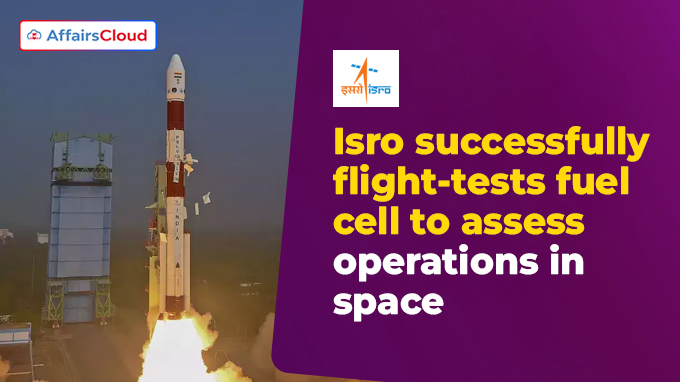 Indian Space Research Organisation (ISRO) has tested a 100-watt(W) class Polymer Electrolyte Membrane Fuel Cell based Power System (FCPS) to assess its operation in space and to collect data to facilitate the design of systems for future missions.
Indian Space Research Organisation (ISRO) has tested a 100-watt(W) class Polymer Electrolyte Membrane Fuel Cell based Power System (FCPS) to assess its operation in space and to collect data to facilitate the design of systems for future missions.
- The test was carried out in ISRO’s orbital platform, PSLV Orbital Experimental Module-3 (POEM3) which was launched onboard Polar Satellite Launch Vehicle (PSLV)-C58 from Satish Dhawan Space Centre in Sriharikota, Andhra Pradesh on 1st January 2024.
Testing:
i.FCPS is an electric generator which works on electrochemical principles.
ii.During the testing of FCPS, 180 W power was generated from Hydrogen(H2) and Oxygen(O2) gases stored in high pressure vessels.
iii.These two gases react to produce electricity, water and small amounts of heat.
Advantages to ISRO:
i.Fuel cell is ideal power source for Space Station as it provide both power and pure water.
ii.Fuel cells are also emission-free.
About POEM3:
i.POEM3 is a low-cost, non-human Indian space station.
ii.It repurposes the fourth stage of PSLV-C58 into a stabilized platform for conducting in-orbit experiments.
- The fourth stage of the rocket was used for the launch of PSLV-C58.
iii.POEM3 aims to conduct 10 experiments including testing of ‘Women Engineered Satellite’ (WESAT) made by the Lal Bahadur Shastri Institute of Technology for Women, Trivandrum (Kerala).
Additional Info:
Fuel cells do not run out of charge and don’t need to be recharged with electricity. They continue to produce electricity as long as there is a supply of hydrogen and oxygen.
VSSC Tested Si–Graphite Anode-Based Lithium-Ion Cells
ISRO’s Vikram Sarabhai Space Centre (VSSC) has tested 10 Ampere Hour (Ah) Silicon(Si)–Graphite anode based High Energy Density Lithium(Li)-ion cells through the POEM3 experiment to assess the anode’s capability to survive and perform in the space environment.
About the Cell:
i.Si-Graphite anode-based cells can accommodate more Li-ions thereby increasing the energy density of the cell to 190 Watt-hour(Wh)/kg with an operating voltage(V) of 4.2 to 2.8 V.
ii.The cell also utilizes readily available materials and a crimped sealing design which reduces hardware and fabrication costs.
iii.These cells are low-weight and low-cost alternatives to present Li-ion cells.
iv.During testing, the battery system worked for 21 hours in 15 orbits and produced a capacity of 8.9 Ampere Hour (Ah) with a final drained voltage of 0.4V
v.Si-Graphite anode cells can also reduce the mass of the battery by 35-40%.
vi.Though the cell was tested for space application, it can also be used on the ground.
Additional Info:
i.The information about the battery such as on-orbit voltage, current and temperature values were acquired through telemetry.
ii.A conventional Li-ion cell uses pure graphite as anode material which can produce an energy of 157 Wh/kg.
About Indian Space Research Organisation(ISRO):
Chairman – Sreedhara Panicker Somanath
Headquarters – Bengaluru, Karnataka
Established in – 1969




